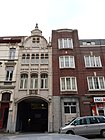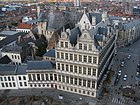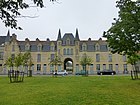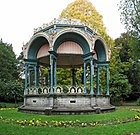Charles van Rysselberghe
Charles van Rysselberghe | |
|---|---|
 Portrait of Charles van Rysselberghe | |
| Born | Carolus Julianus van Rysselberghe 25 July 1850 |
| Died | 30 April 1920 (aged 69) |
| Nationality | Belgian |
| Occupation | Architect |
| Buildings | Museum of Fine Arts in Ghent Zebrastraat in Ghent |
Charles van Rysselberghe (25 July 1850 – 30 April 1920) was a Belgian architect.
Biography
Carolus Julianus van Rysselberghe was born in Meerle, Hoogstraten, on 25 July 1850.[1][2] He was trained at the Academy of Ghent, studying there between 1863 and 1875. After his education at the academy, he was honored with the Prize of the City of Ghent.[1]
He was municipal architect of the city of
His best known work, however, is the Museum of Fine Arts, built between 1898 and 1904 and extended in 1912.[1][5]
Van Rysselberghe also taught architecture at the Ghent academy. In 1905, he was one of the founders of the Ghent Workers Housing Company. It was one of the first social housing associations in Belgium, and for it he completed five projects. Van Rysselberghe had limited resources for this work, but still managed a polychrome use of materials on a lively design.[1]
Selected works
- 1880–1881: Intermediate section of Ghent City Hall, built along the Poeljemarkt between the Aldermen's House of Gedele and the Armenkamer
- 1887–1888: City school on Kaprijkestraat in Ghent
- 1891: Urban boy school on Drongensesteenweg in Ghent
- 1891: City school on Désiré Van Monckhovenstraat in Ghent
- 1893: City school on Molenaarsstraat in Ghent
- 1898: Urban primary school for girls on Acaciastraat in Ghent
- 1898–1904: Museum of Fine Arts of Ghent
- 1901–02: Fire station on Londenstraat in Ghent
- 1904: City school on Frans van Ryhovelaan/Lavendelstraat in Ghent
- 1911–1912: Social housing on Bellefleurstraat in Ghent
- 1912–1913: Social housing on Biezenstuk/Rooigemlaan in Ghent
- 1914: Urban school for girls on Lammensstraat in Ghent
-
Civil house on Belfortstraat in Ghent
-
Urban elementary school for boys on Acaciastraat in Ghent
-
Corner house on Belfortstraat in Ghent
-
Intermediate section of Ghent City Hall built along the Poeljemarkt
-
Urban school for girls on Lammensstraat in Ghent
-
Gatehouse of city school on Molenaarsstraat in Ghent
-
Laurent Institute in Ghent
-
Fire station on Londenstraat in Ghent
-
Music kiosk in Citadelpark, Ghent
See also
References
- ^ a b c d e f g "Van Rysselberghe, Charles". Inventaris Vlaanderen. Archived from the original on 30 December 2021. Retrieved 2 January 2022.
- ISBN 9789087045517. Retrieved 2 January 2022.
- ISBN 9782873861193. Retrieved 2 January 2022.
- ^ Société d'histoire et d'archéologie de Gand (1980). Handelingen der Maatschappij voor Geschiedenis en Oudheidkunde te Gent - Volumes 34-36. p. 164. Retrieved 2 January 2022.
- ISBN 9780199837335. Retrieved 2 January 2022.
Further reading
- D. Laporte, Architectuurgids Gent, Turnhout, 1994.
- Francis Strauven, "Van Rysselberghe, Charles", dans: Dictionnaire de l'architecture en Belgique, Anvers : Mercator, 2003, p. 584-585.










